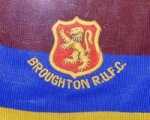Broughton RUFC
 | |
| Full name | Broughton Rugby Union Football Club |
|---|---|
| Nickname(s) |
Broughton Griffins formerly Broughton Wasps |
| Founded | 1869[1] |
| Location | Salford, Greater Manchester, England |
| Ground(s) | Broughton Cricket & Rugby Club, Yew Street, Salford |
| League(s) | North 1 West |
| Official website | |
|
www | |
Broughton Rugby Union Football Club is a rugby union club based in Salford, Greater Manchester, which at the time of the club's founding in 1869 was in Lancashire, England. Its home venue is the Broughton Cricket & Rugby Club pitch on Yew Street. Broughton, although it currently occupies a low position in the English rugby union league system, is notable for its early important contributions to the development of rugby union most predominantly in the north of England, but also nationally. Broughton also hosted the first ever rugby match played under floodlights.
History
Broughton was the first Broughton football club in Manchester,[2] founded by members of a club known in 1869 as Broughton College, formed from former pupils of Broughton College, a public school in Salford at the time.[1] Its foundation in 1869 predates both the formation of Broughton Rangers (1877) and Broughton Park RUFC (1882). After playing two or three seasons on the Broughton Cricket Ground they changed their appellation to the Broughton Wasps, and soon played some of the strongest teams in the North. In 1877, the same year that Broughton Rangers were formed, the Wasps amalgamated with another Broughton club known as Wellington, who it is reported "were the first club to introduce the passing game into Lancashire, and brought it to such perfection, that, in spite of their youth, they succeeded in beating many of the principal clubs of the district.".
Lancashire Football Union
Broughton also played a pivotal role in the formation of the Lancashire Football Union (later to be called the Lancashire County Rugby Football Union). From 1870 to 1881 the government and arrangement of county matches in Lancashire had been vested in Manchester Football Club. Though self-appointed, Manchester was recognised as the authority by the other great Lancashire club, Liverpool.[3] However, a movement of emerging new clubs, headed by W. Bell, the honorary secretary of the Broughton Football Club, had an objective to secure a voice in the selection of county teams. In 1881 a general meeting of Lancashire clubs was called at which the following clubs were represented: Manchester Rangers; Free Wanderers; Broughton; Swinton; Walton; Rossendale; Oldham; Manchester Athletic; Rochdale Hornets; Chorley Birch; and Cheetham and a resolution to form the Lancashire Football Union was agreed. The initial committee had W. Bell as its honorary secretary and G. C. Lindsay as the honorary treasurer.[3] Two county matches were arranged altogether versus the Midland Counties and Lanarkshire (Scotland). Manchester then decided to wrest control of the county back and on December 22, 1881, met with the new Union and a duly constituted and representative governing body, its club to be called The Lancashire County Football Club, was formed. Although the president, vice-presidents, the hon. secretary and treasurer were elected from the Manchester Football Club and the Liverpool Club, Broughton was represented by Bell on the committee.
The first floodlit match
Prior to the events leading to the formation of the Lancashire Union, Broughton was also the home side in the first rugby match under floodlights when they played Swinton in Salford on 22 October 1878. The match took place at Broughton's Yew Street ground in Salford and the floodlights used were two Gramme's lights, suspended from 30 feet poles. The match was comprehensively won by Broughton by two-goals, three tries, and three touchdowns to Swinton's none. A report in the Salford Weekly News dated 2 November 1878, provided some details of the match: "C.Sawyer kicked one of the goals from the field of play. Mudie the other from a fine try by J.Sawyer, while the three unsuccessful tries were secured by Riley, A.Bowam and Shut". The report went on to detail that probably "8,000 to 10,000 persons were present when the time for kick-off arrived".[4] Following the Broughton experiment with lights another match took place in Liverpool later that month under floodlights and very soon the practice became popular as the electric companies attempted to overturn the monopoly exercised by the gas companies.[4]
Later history
In the 1880s Broughton began to produce some players of international standing including C.M. Sawyer, J. H. Payne, and F. Moss.[1]
Notable former players
- C. M. Sawyer (first capped 1880)
- J. H. Payne (first capped 1882)
- F. Moss (first capped 1885)
References
- ↑ 1.0 1.1 1.2 Francis Marshall, Football, the rugby union game
- ↑ Tony Collins, Rugby's great split: class, culture and the origins of rugby league football, page 8, (Taylor & Francis), 2006, ISBN 0-415-39616-6, ISBN 978-0-415-39616-5
- ↑ 3.0 3.1 Francis Marshall, Football; the Rugby union game, page 373, London
- ↑ 4.0 4.1 Rugby Football History online